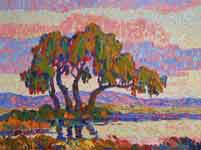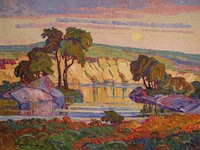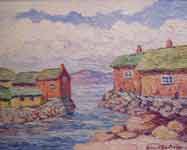Birger Sandzén’s decision early in life to become a painter was challenged when he decided to depart his native Sweden for a teaching position in America’s Great Plains. This new adventure, which landed him in Lindsborg, Kansas, however, would open up a new world which was continually expanded by further travels within America and Mexico.
In the fall of 1894, Sandzén arrived to teach at Bethany College. He was greeted by John Swensson and Olof Grafström, the current Bethany art instructor, in McPherson, Kansas, and traveled by wagon to Lindsborg. There he was greeted by College president Dr. Carl Aaron Swensson at the Main Building. Sandzén’s first principal assignment during the first year was to teach classes in Swedish, German and French and assist Olof Grafström in the art department. Grafström continued in the art department until 1897 and was followed by Sandzén’s friend from Sweden, Carl Lotave. Lotave continued until 1899 and Sandzén replaced him as department chair. He would continue in that position until his retirement in 1946.
In 1908, Sandzén saw the Rocky Mountains for the first time: with their great masses of shale and granite, rugged mountain peaks, penetrating light and deep shadows. Although he had been introduced to the broad horizon and intense light of the prairies, few things captured his attention as did the Rockies.
His life in this isolated middle region of America led to the development of a strong, early modern, expressionist style of painting.
Sandzén interpreted the landscape. His motifs were often planned by sketches and drawings. In an article published in 1915 he stated his views on the special relationship of landscape to the use of color: “I feel that one should be guided in both composition and use of color by the character of the landscape. There are western motifs out here, especially in a certain light (for example, in gray weather), which are distinguished by their majestic lines as in protruding rocks, rolling prairie and winding ravines. One should, when painting such motifs, first of all emphasize the rhythm and then sum up the color impression in a few large strokes. In other words: a severe decorative treatment is best adapted for this purpose. However, it should not be understood that color is less significant. No not at all. The color arrangement, however simple it may be, should support and enforce the lines. A false arrangement of color may completely destroy the rhythm. In the atmosphere in which the intensive light vibration and ring of color produce the great poser of light which is often the situation in the dry air of the Southwest — it is clear that a color technique should be used that emphasizes the most characteristic feature of the landscape. One must then use pure colors which refract each other, but which through distance assimilate for the eye — the so-called “optical” blending — since the usual blending on the palette, the ‘pigmented blending,’ is not intensive enough and does not ‘vibrate.'”
Sandzén preferred that his palette be neither too simple nor too complicated: “There are four or five pigments that no painter can do without. As to the rest, there is plenty of room for individual taste… Vary your palette for different subjects… We can get every imaginable color by mixing a few pigments, but too much mixing kills the color.”
Sandzén’s palette was varied: titanium and permeable white; cadmium yellow, medium; cadmium red, medium; yellow ocher; raw sienna; alizarin crimson; permanent green, light; emerald green; French ultramarine blue; and cobalt violet. This palette was well suited to his paintings of Colorado. Colorado and the Rocky Mountains would lure both Sandzén and his family to the Garden of the Gods, Boulder and Estes Park for more than three decades. A 1927 itinerary included Bryce Canyon and Zion Canyon in Utah and the Grand Canyon of Arizona. Many paintings by Sandzén provide an eloquent testimony to his love of the landscape in the West and the Southwest.
Margaret, his daughter, accompanied Sandzén on a trip to Mexico in l935. They journeyed to Taxco and it was a pleasant and rewarding experience for father and daughter. Previously, Sandzén had visited Mexico one time before in 1899.
Sandzén enjoyed the experience of sketching in the Smoky Valley, where he often drew the homesteads of the early settlers. The oil The Old Homestead is of a home that was near Coronado Heights. He also made numerous sketches while visiting the family farm of his wife’s parents in Graham County, Kansas. This western Kansas setting, near Bogue and Hill City, gave him a good measure of the vast, broad landscape of the Great Plains. Nearby Wild Horse Creek, with outcroppings of limestone rock, became a favorite motif for his oils, watercolors and prints.
A more personal study of Sandzén reveals his personal qualities of strong character, optimism, and congenial spirit. These factors are clearly discernible in his art.
Throughout his life in America, Sandzén was an avid seeker of ideas and impressions that would contribute to his understanding nature, which he often called the “great teacher.”



